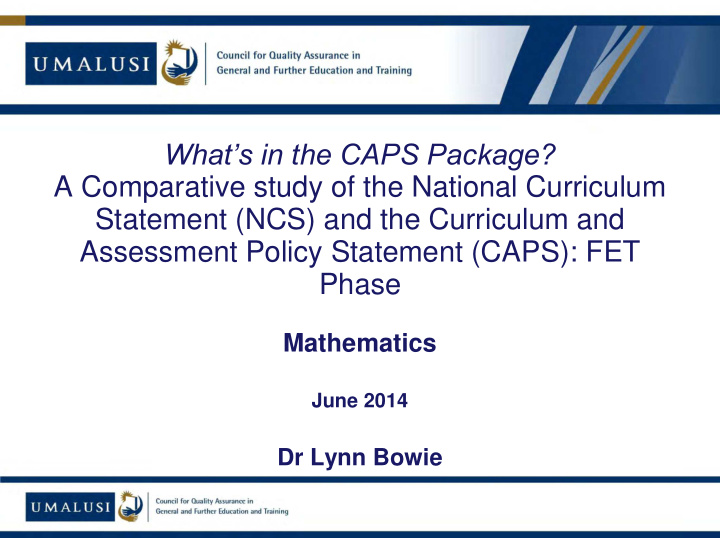



What’s in the CAPS Package? A Comparative study of the National Curriculum Statement (NCS) and the Curriculum and Assessment Policy Statement (CAPS): FET Phase Mathematics June 2014 Dr Lynn Bowie
Team Members Dr Lynn Bowie, Mathematics Education Coordinator, Olico Dr Zain Davis, Senior Lecturer in Mathematics Education at UCT Mr Hector Nxumalo, Deputy Chief Education Specialist, KZN Prof Poobhalan Pillay, Professor in Mathematics, Umalusi external moderator Ms Leigh Pleass, Master Teacher, SABJE Mrs Mariamma Raju, Senior Education Specialist, Eastern Cape
NCS CAPS Paper 1: Paper 1: Algebra, Sequences, Functions, Algebra, Sequences, Functions, Calculus, Finance, Probability Calculus, Linear Programming, Finance Paper 2: Paper 2: Coordinate geometry, Coordinate geometry, Transformation geometry, Euclidean geometry, Trigonometry, Statistics Trigonometry, Statistics (including regression and Paper 3: (done by <5% of correlation) Mathematics learners) Euclidean geometry, Probability and Statistics
NCS CAPS Paper 1: Paper 1: Algebra, Sequences, Functions, Algebra, Sequences, Functions, Calculus, Linear Programming, Calculus, Finance, Probability Finance Paper 2: Paper 2: Coordinate geometry, Coordinate geometry, Transformation geometry, Euclidean geometry, Trigonometry, Statistics Trigonometry, Statistics Paper 3: (done by <5% of (including regression and Mathematics learners) correlation) Euclidean geometry, Probability and Statistics
NCS: format and user-friendliness
NCS Learning Outcomes Learning Outcome 1: Number and Number Relationships Learning Outcome 2: Functions and Algebra Learning Outcome 3: Space, Shape and Measurement Learning Outcome 4: Data Handling and Probability
NCS Assessment Standards e.g. We know this when the learner is able to:
Exam guidelines
CAPS format and user-friendliness Introduction to the curriculum and assessment policy statements 1. Background , Overview, General aims of the South African Curriculum, Time allocation Introduction to Mathematics 2. What is Mathematics?, Specific Aims, Specific Skills Focus of Content Areas, Weighting of Content Areas, Mathematics in the FET Overview of topics per term and annual teaching plans 3. Specification of content to show Progression Content clarification with teaching guidelines (includes allocation of teaching time, sequencing and pacing of topics, topic allocation per term) Assessment in Mathematics 4. Introductions, informal or daily assessment, formal assessment, programme of assessment, recording and reporting, moderation of assessment, general
CAPS Topics Functions Number Patterns, Sequences and Series Finance, growth and decay Algebra Differential Calculus Probability Euclidean geometry and Measurement Analytical Geometry Trigonometry Statistics
CAPS: Overview of topics section Grade 10 Grade 11 Grade 12 NUMBER PATTERNS, SEQUENCES AND SERIES Investigate number patterns Investigate number patterns Identify and solve problems leading to those where there leading to those where there involving number patterns is constant difference is a constant second that lead to arithmetic and between consecutive terms, difference between geometric sequences and and the general terms is consecutive terms and the series, including infinite therefore linear general terms is therefore geometric series quadratic FINANCE, GROWTH AND DECAY etc
CAPS: allocation of teaching time
CAPS: Topic allocation per term
CAPS: Clarification column
Coverage
Coverage
Coverage 250 200 number of subtopics 150 NCS CAPS 100 50 0 Grade 10 Grade 11 Grade 12 overall
Summarising change in depth
Weighting of Mathematics in the curriculum Subject time allocation NCS the CAPS Total classroom time 4.5 hours per week 4.5 hours per week allocated for Mathematics in the phase % of total classroom time 16% 16%
Weighting (marks) 18% 16% 14% 12% 10% 8% 6% NCS Overall 4% the CAPS Overall 2% 0%
Entrance level requirements A facility with number and calculations with number An understanding of number and number systems and the generalisations of these properties using the language of algebra Some basic facility with the language of algebra Understanding of the geometric meanings of the coordinates of points in the Cartesian plane. Work with the geometry of lines and triangles and experience of working with geometric shapes Basic understanding of collecting, organising and representing data An orientation to mathematics that includes sense-making, explanation, justification and application in context.
Comments on exit level outcomes Functions: move between different representations Sequences and series: investigate different sequences, arithmetic and geometric sequences and series Finance, growth and decay: interpret and solve problems based on situations relating to interest and annuities Algebra: ability to work fluently with language of algebra Calculus: basic, largely intuitive understanding of derivatives and ability to apply them Probability: understanding of key ideas in calculating probability Euclidean geometry: work with geometry of polygons and circles deductively. Analytical geometry: Work with points, line segments, lines and circles on the Cartesian plane Trigonometry: Work with trig functions and apply them to geometric situations Statistics: Work with univariate and bivariate data
Comments on exit level outcomes Functions: restricted list. Limited to functions given by equations. Calculus: meaning of 1 st derivative Geometry: Notions of proofs and axiomatic systems Trigonometry: Functions limited to domain -360 o to 360 o Aims at generic level not sufficiently pulled through into body of curriculum (e.g. modelling, conjecturing, generalisation , justification and proof)
Comments Cannot increase breadth Weighting of levels of cognitive demand Knowledge 20% Look for places to Routine Procedures 35% increase depth Complex Procedures 30% Problem Solving 15% BUT
Performance in Maths NSC (pre-CAPS)
Recommend
More recommend